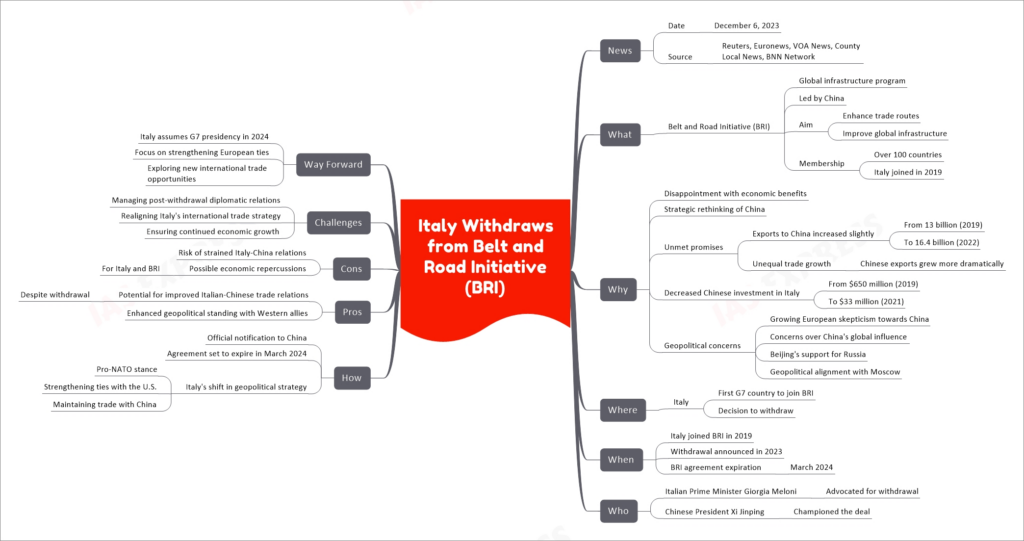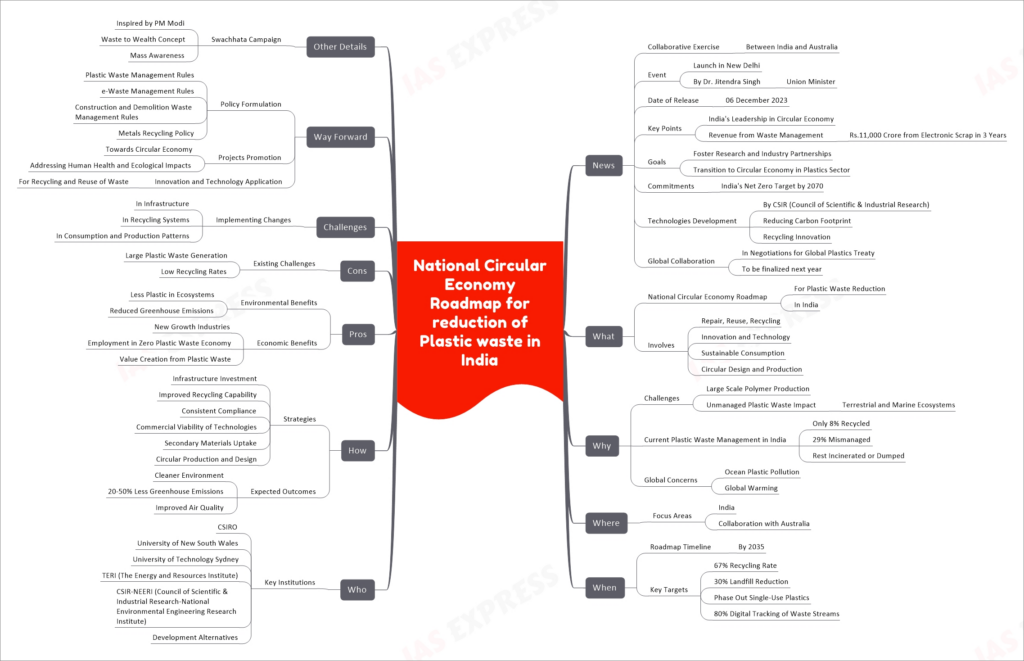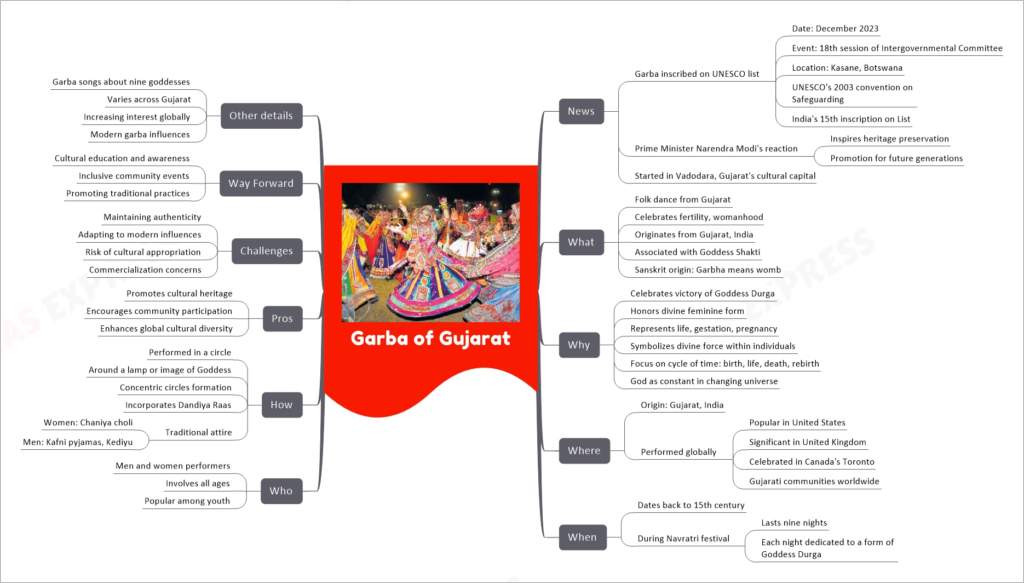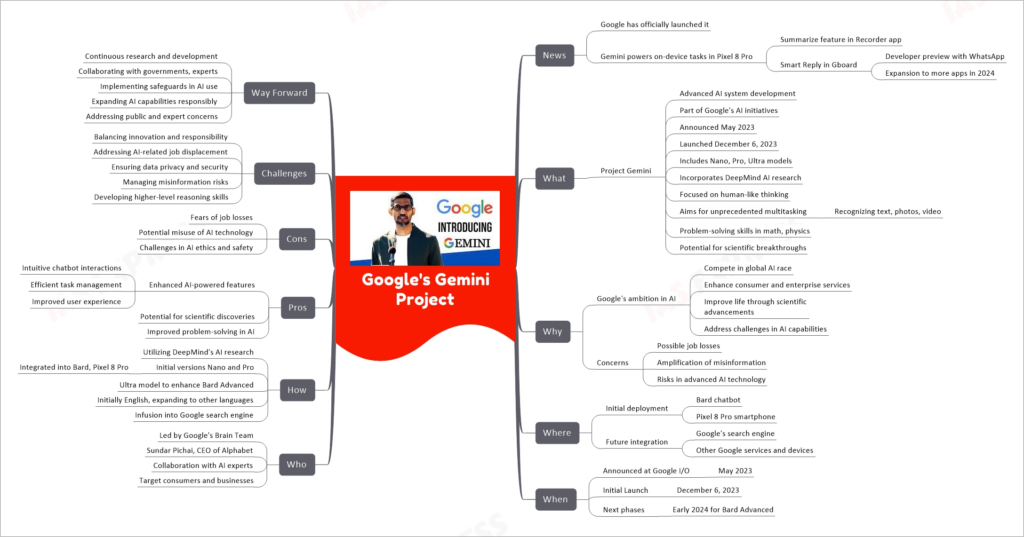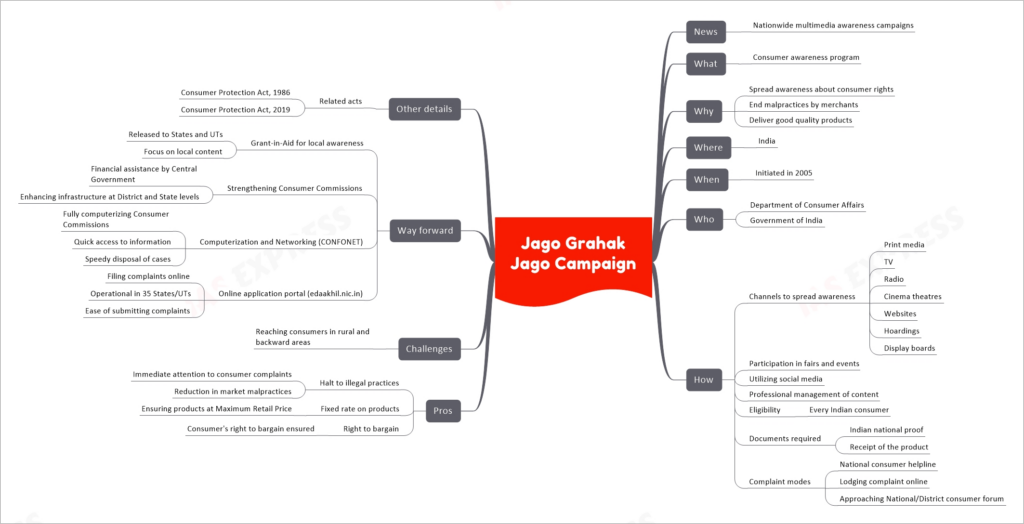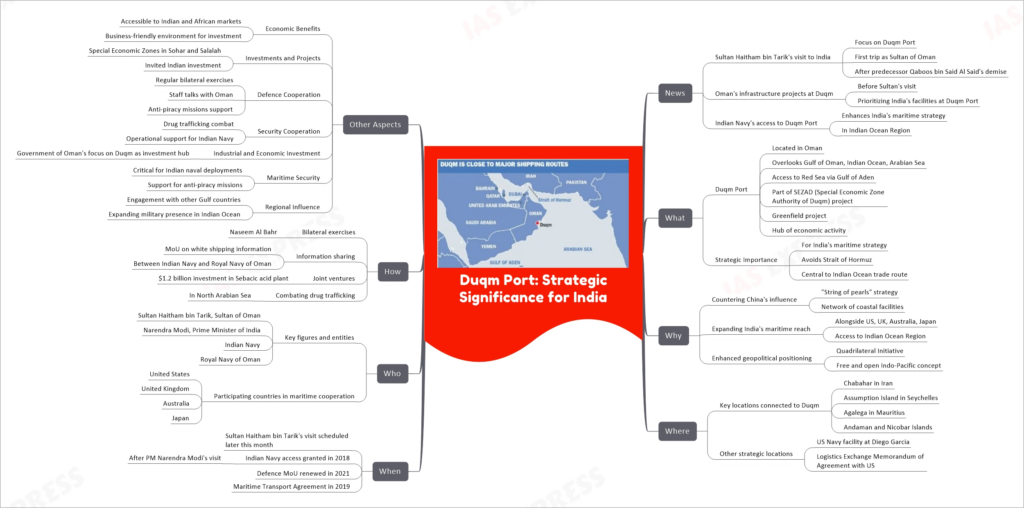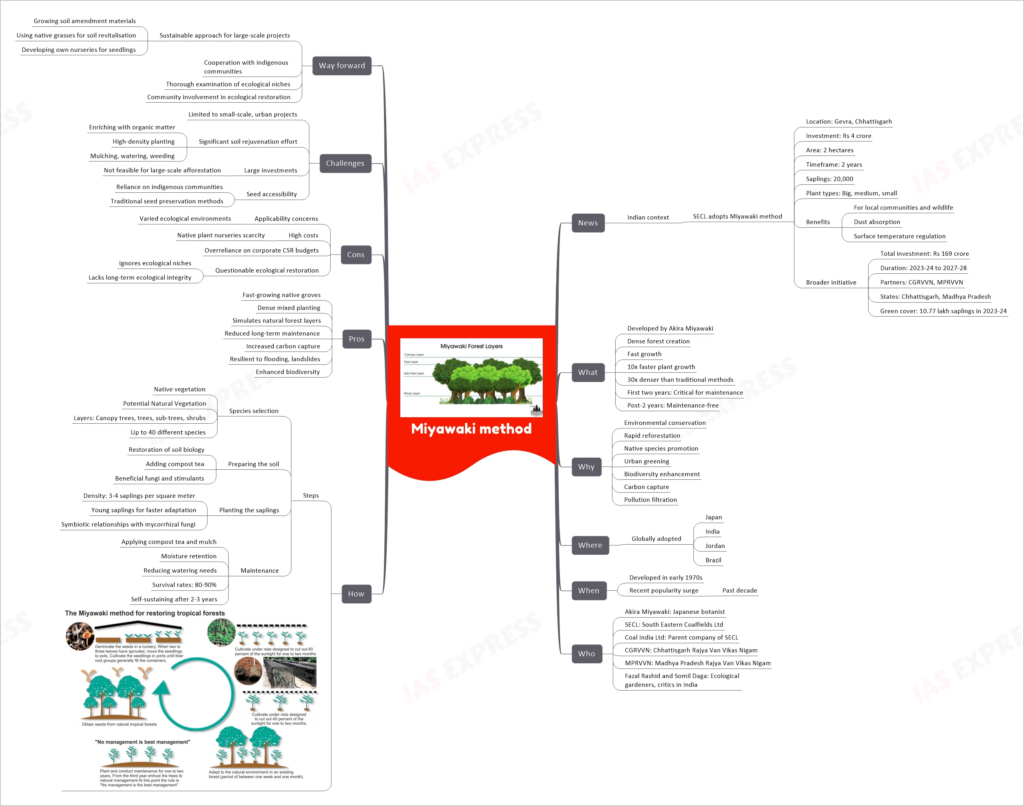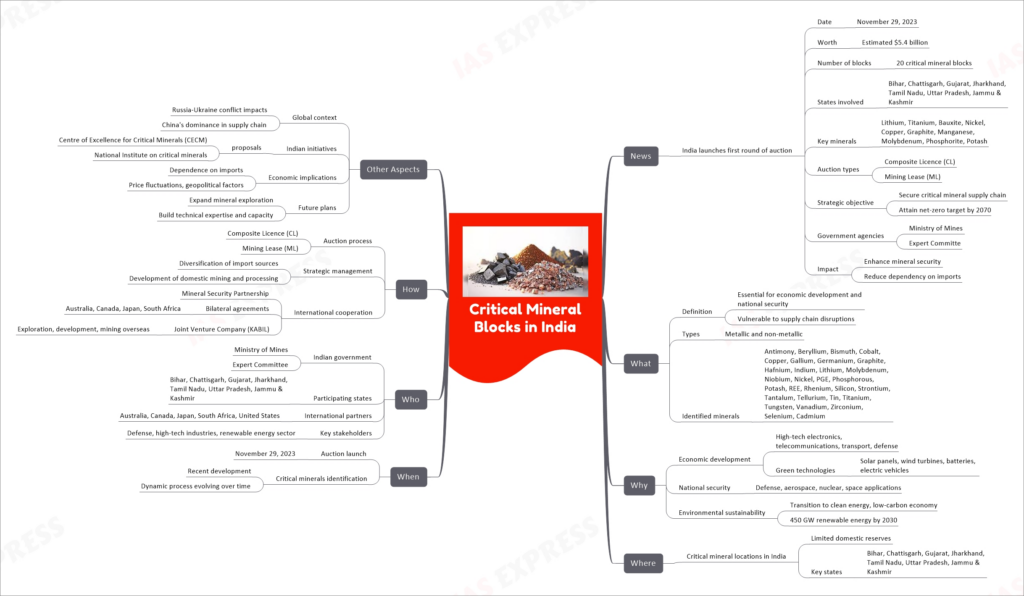[Newsbits] 7.12.2023 – Google’s Gemini, Miyawaki Method, Duqm Port, & More

| Category | Subcategory | Details |
|---|---|---|
| News | Nationwide launch | Date: December 4, 2023 Location: New Delhi |
| What | Digital Commerce Innovation | Challenges addressed: Diverse issues in digital commerce Promotion: Industry innovation |
| Why | Tapping Potential | Focus: India’s technological and entrepreneurial capacity |
| Where | National scale | Cities involved: Over 50 |
| When | Announcement date | Date: December 4, 2023 Event: Problem statements unveiled, Invitation for registration |
| Who | Open Network for Digital Commerce (ONDC) – a private non-profit company established by the Department for Promotion of Industry and Internal Trade (DPIIT) Partners: Google Cloud India, Antler in India, Paytm, Protean, Startup India | |
| How | Participative framework | Ecosystem-driven approach Categories: – NextGen Ventures (Venture creation focus, Capital raising pathway, Launching and scaling companies, Business incubation) – Scalable solutions (Participant focus, Organizations and individuals, Network Participants’ friction points) – Foundation solutions (College students, Proof of concept identification) |
| Winners | Benefits: Opportunities, Mentorship, Equity-free grants, Cloud credits | |
| Pros | Innovation stimulation | Digital Commerce Ecosystem Growth: Sustainable business development |
| Challenges | Diverse digital commerce issues: Solution development | |
| Way Forward | Unleashing startup and student potential: Meaningful impact creation at scale |
| Category | Subcategory | Details |
|---|---|---|
| News | Date | December 6, 2023 |
| What | Belt and Road Initiative (BRI) | Global infrastructure program |
| Led by China | ||
| Aim | ||
| – Enhance trade routes | ||
| – Improve global infrastructure | ||
| Membership | ||
| – Over 100 countries | ||
| – Italy joined in 2019 | ||
| Why | Disappointment with economic benefits | |
| Strategic rethinking of China | ||
| Unmet promises | ||
| – Exports to China increased slightly | ||
| From 13 billion (2019) | ||
| To 16.4 billion (2022) | ||
| – Unequal trade growth | ||
| Chinese exports grew more dramatically | ||
| – Decreased Chinese investment in Italy | ||
| From $650 million (2019) | ||
| To $33 million (2021) | ||
| – Geopolitical concerns | ||
| Growing European skepticism towards China | ||
| Concerns over China’s global influence | ||
| Beijing’s support for Russia | ||
| Geopolitical alignment with Moscow | ||
| Where | Italy | First G7 country to join BRI |
| Decision to withdraw | ||
| When | Italy joined BRI | 2019 |
| Withdrawal announced | 2023 | |
| BRI agreement expiration | March 2024 | |
| Who | Italian Prime Minister | Giorgia Meloni |
| Advocated for withdrawal | ||
| Chinese President | Xi Jinping | |
| Championed the deal | ||
| How | Official notification to China | |
| Agreement set to expire | March 2024 | |
| Italy’s shift in geopolitical strategy | ||
| – Pro-NATO stance | ||
| – Strengthening ties with the U.S. | ||
| – Maintaining trade with China | ||
| Pros | Potential for improved Italian-Chinese trade relations | |
| Despite withdrawal | ||
| Enhanced geopolitical standing with Western allies | ||
| Cons | Risk of strained Italy-China relations | |
| Possible economic repercussions | ||
| For Italy and BRI | ||
| Challenges | Managing post-withdrawal diplomatic relations | |
| Realigning Italy’s international trade strategy | ||
| Ensuring continued economic growth | ||
| Way Forward | Italy assumes G7 presidency in 2024 | |
| Focus on strengthening European ties | ||
| Exploring new international trade opportunities | ||
| Other Details | Italy’s initial hopes for BRI | |
| – Attract investment | ||
| – Expand exports | ||
| – Counterbalance EU skepticism | ||
| Context | Italy’s economic struggles pre-BRI | |
| Populist government’s outlook | ||
| Global Impact | BRI scaled back | |
| – Debt distress in recipient countries | ||
| – Chinese banks reducing risky loans | ||
| European focus on “de-risking” economies |
On December 6, 2023, a significant event took place in New Delhi, where Dr. Jitendra Singh, the Union Minister, launched the National Circular Economy Roadmap for reducing plastic waste in India. This collaborative effort between India and Australia aims to address the pressing issue of plastic waste. In this article, we will delve into the key points, goals, commitments, technologies, and global collaboration associated with this roadmap.
Key Points
- India’s Leadership in Circular Economy: India is taking a leadership role in the global effort to transition towards a circular economy, with a particular focus on tackling plastic waste.
- Revenue from Waste Management: In the last three years, India has generated Rs. 11,000 Crore from managing electronic scrap, showcasing the economic potential of waste management.
- Foster Research and Industry Partnerships: The roadmap aims to encourage collaboration between research institutions and industries to drive innovation in plastic waste management.
- Transition to Circular Economy in Plastics Sector: India is committed to transforming its plastics sector into a circular economy, focusing on repair, reuse, recycling, sustainability, and circular design.
- India’s Net Zero Target by 2070: India is committed to achieving net-zero greenhouse gas emissions by the year 2070.
- By CSIR (Council of Scientific & Industrial Research): The Council of Scientific & Industrial Research is spearheading efforts to develop technologies that reduce the carbon footprint and promote recycling innovation.
- In Negotiations for Global Plastics Treaty: India is actively engaged in negotiations for a global plastics treaty, which is expected to be finalized next year.
What
- Involves: The roadmap focuses on four main pillars: repair, reuse, recycling, innovation and technology, sustainable consumption, and circular design and production.
Why
Challenges
- Large Scale Polymer Production: India faces challenges in managing the large-scale production of polymers, leading to significant plastic waste.
- Unmanaged Plastic Waste Impact: Unmanaged plastic waste poses a severe threat to terrestrial and marine ecosystems, causing environmental degradation.
Current Plastic Waste Management in India
- Only 8% Recycled: A mere 8% of plastic waste in India is recycled, highlighting the need for better waste management practices.
- 29% Mismanaged: Approximately 29% of plastic waste is mismanaged, further exacerbating environmental issues.
Global Concerns
- Ocean Plastic Pollution: The global concern over ocean plastic pollution and its impact on marine life is a driving force behind this initiative.
- Global Warming: Plastic waste contributes to global warming, making it crucial to reduce its environmental impact.
Where
- Focus Areas: The initiative primarily focuses on addressing plastic waste issues within India while collaborating with Australia to exchange knowledge and expertise.
When
- By 2035: The roadmap sets a goal to achieve a 67% recycling rate, reduce landfill usage by 30%, phase out single-use plastics, and implement an 80% digital tracking system for waste streams.
Who
Key Institutions
- CSIRO: The Commonwealth Scientific and Industrial Research Organisation (CSIRO) is a key player in developing solutions for plastic waste management.
- University of New South Wales: This university contributes to research and innovation in the field.
- University of Technology Sydney: Another educational institution actively involved in circular economy initiatives.
- TERI (The Energy and Resources Institute): TERI plays a significant role in sustainable development.
- CSIR-NEERI (Council of Scientific & Industrial Research-National Environmental Engineering Research Institute): This institution contributes its expertise to the cause.
- Development Alternatives: A key partner in driving circular economy solutions.
How
Strategies
- Infrastructure Investment: Investments in waste management infrastructure are crucial for effective plastic waste reduction.
- Improved Recycling Capability: Enhancing recycling capabilities is a key strategy.
- Consistent Compliance: Ensuring consistent compliance with waste management rules and regulations.
- Commercial Viability of Technologies: Making plastic recycling technologies economically viable.
- Secondary Materials Uptake: Promoting the use of secondary materials in production.
- Circular Production and Design: Emphasizing circular design principles in production processes.
Expected Outcomes
- Cleaner Environment: Effective plastic waste management will lead to a cleaner environment.
- 20-50% Less Greenhouse Emissions: Reducing plastic waste will result in a significant reduction in greenhouse gas emissions.
- Improved Air Quality: Better waste management practices will contribute to improved air quality.
Pros
Environmental Benefits
- Less Plastic in Ecosystems: Reducing plastic waste will protect ecosystems from pollution.
- Reduced Greenhouse Emissions: Lowering plastic waste helps combat global warming.
Economic Benefits
- New Growth Industries: The circular economy initiative can create new industries and jobs.
- Employment in Zero Plastic Waste Economy: Employment opportunities will arise in a zero plastic waste economy.
- Value Creation from Plastic Waste: Plastic waste can be turned into a valuable resource.
Challenges
- Large Plastic Waste Generation: India faces a significant challenge due to the high volume of plastic waste generated.
- Low Recycling Rates: Low rates of recycling exacerbate the plastic waste problem.
- Implementing Changes: Implementing changes in infrastructure, recycling systems, and consumption and production patterns poses a challenge.
Way Forward
Policy Formulation
- Plastic Waste Management Rules: Strengthening rules and regulations for managing plastic waste.
- e-Waste Management Rules: Effective management of electronic waste.
- Construction and Demolition Waste Management Rules: Managing construction and demolition waste efficiently.
- Metals Recycling Policy: Developing a policy for recycling metals.
Projects Promotion
- Towards Circular Economy: Promoting projects that align with the circular economy concept.
- Addressing Human Health and Ecological Impacts: Focusing on projects that address health and ecological concerns.
Innovation and Technology Application
- For Recycling and Reuse of Waste: Embracing innovation and technology to improve recycling and reuse of waste materials.
Other Details
Swachhata Campaign
- Inspired by PM Modi: The Swachhata Campaign draws inspiration from Prime Minister Modi’s vision for a cleaner India.
- Waste to Wealth Concept: Promoting the idea of converting waste into wealth.
- Mass Awareness: The campaign aims to create mass awareness about the importance of waste management.
Conclusion:
The National Circular Economy Roadmap for reducing plastic waste in India, in collaboration with Australia, represents a significant step towards addressing plastic pollution and fostering a sustainable future. With clear goals, strategies, and commitments, India is on the path to creating a cleaner environment, reducing greenhouse emissions, and unlocking economic opportunities through effective plastic waste management. The challenges ahead will require continuous innovation, policy formulation, and public awareness campaigns to achieve a plastic waste-free India.
In a momentous event that unfolded at the 18th session of the Intergovernmental Committee in Kasane, Botswana, in December 2023, Garba, the traditional folk dance of Gujarat, was inscribed on the prestigious UNESCO list. This recognition marks a significant milestone in the realm of cultural preservation and heritage celebration. Prime Minister Narendra Modi’s enthusiastic response to this acknowledgment underscores its importance, not only for the present but also for the future generations. Garba, which had its origins in Vadodara, Gujarat’s cultural capital, has now achieved global recognition and acclaim.
What is Garba?
Garba is a vibrant and lively folk dance that hails from the state of Gujarat in India. Rooted in the celebration of fertility and womanhood, this dance form is deeply associated with Goddess Shakti, the divine feminine energy. The name “Garba” itself has a Sanskrit origin, with “Garbha” meaning womb. This etymology reflects the dance’s profound connection to the concept of creation and life’s cyclical nature.
Why is Garba Celebrated?
Garba serves as a joyful celebration of the victory of Goddess Durga and honors the divine feminine form. Through its intricate movements and rhythmic patterns, Garba symbolizes various aspects of life, including gestation, pregnancy, and the divine force that resides within individuals. It emphasizes the eternal cycle of time, encompassing birth, life, death, and rebirth, recognizing the constancy of divinity within a changing universe.
Where is Garba Practiced?
Originating in Gujarat, India, Garba has transcended geographical boundaries and is now performed globally. It has gained immense popularity in the United States, holds significant cultural value in the United Kingdom, and is celebrated with great enthusiasm in Toronto, Canada, among Gujarati communities worldwide.
When is Garba Performed?
Garba traces its roots back to the 15th century and is an integral part of the Navratri festival. This festival spans nine nights, with each night dedicated to a specific form of Goddess Durga. The dance performances during Navratri are a tribute to the divine and are filled with spiritual fervor.
Who Participates in Garba?
Garba is an inclusive art form that welcomes performers of all ages, from the young to the elderly. It is a dance that unites men and women in a jubilant celebration of culture and tradition. Its popularity among the youth ensures that this rich heritage continues to thrive.
How is Garba Performed?
The dance is typically performed in a circular formation, with participants dancing around a lamp or an image of Goddess Shakti. The concentric circles created by the dancers symbolize unity and harmony. Garba often incorporates the energetic Dandiya Raas dance and features traditional attire, with women wearing Chaniya choli and men donning Kafni pyjamas and Kediyu.
Pros, Cons, and Challenges
While Garba promotes cultural heritage and encourages community participation, it also faces challenges. There is a risk of cultural appropriation and concerns about commercialization. Balancing authenticity with modern influences presents a challenge, but it is crucial to preserve the essence of this age-old tradition.
The Way Forward
To ensure the continued preservation and celebration of Garba, cultural education and awareness are vital. Inclusive community events can foster a sense of belonging and pride in this cultural heritage. Promoting traditional practices while embracing modernity can strike a harmonious balance that allows Garba to evolve while staying true to its roots.
Other Notable Details
Garba songs often revolve around the worship of the nine goddesses. The dance varies across different regions of Gujarat, showcasing its diversity and adaptability. As interest in Garba continues to grow globally, it also incorporates modern influences, demonstrating its ability to remain relevant and captivating in the ever-changing cultural landscape.
In conclusion, the recognition of Garba as an Intangible Cultural Heritage by UNESCO is a momentous occasion that celebrates the rich cultural tapestry of Gujarat and India as a whole. This vibrant dance form, with its deep-rooted symbolism and inclusivity, serves as a testament to the enduring power of tradition and the importance of preserving our shared heritage.
Google is constantly pushing the boundaries of technology, and its latest project, Gemini, is no exception. With its recent update powering on-device tasks in the Pixel 8 Pro and other exciting developments, Gemini is set to revolutionize the world of artificial intelligence (AI).
What is Google’s Gemini Project?
Google’s Gemini Project is an advanced AI system that represents a significant milestone in the company’s AI initiatives. Announced in May 2023 and launched on December 6, 2023, it consists of multiple models, including Nano, Pro, and Ultra. At its core, Gemini incorporates cutting-edge AI research from DeepMind and is designed to emulate human-like thinking, with a focus on multitasking and problem-solving. Here’s a closer look:
Advanced AI Development:
- Gemini is a testament to Google’s commitment to advancing AI technologies.
- It aims to compete in the global AI race and enhance both consumer and enterprise services.
- The project also has the lofty goal of improving human life through scientific advancements.
Multitasking Mastery:
- Gemini is built to handle on-device tasks that involve recognizing text, photos, and even videos.
- It possesses problem-solving skills, particularly in fields like math and physics.
- The potential for scientific breakthroughs is a driving force behind the project.
Why is Gemini Important?
Google’s Ambition in AI:
- Google seeks to maintain its competitive edge in AI on a global scale.
- Gemini is expected to elevate consumer and enterprise services to new heights.
- The project aims to address ongoing challenges in AI capabilities and drive innovation.
Concerns and Challenges:
- Gemini raises concerns about possible job losses due to automation.
- There’s also the risk of misinformation being amplified through advanced AI technology.
- Ethical considerations and safety are significant challenges in the development of such powerful AI.
Where is Gemini Deployed?
Initial Deployment:
- The Bard chatbot is the first recipient of Gemini’s AI capabilities.
- Gemini powers on-device tasks in the Pixel 8 Pro smartphone.
Future Integration:
- Google plans to integrate Gemini into its search engine and other services and devices in the future.
When Can We Expect More?
- Gemini was officially announced at Google I/O in May 2023.
- The initial launch took place on December 6, 2023.
- The next phases, including Bard Advanced, are expected in early 2024.
Who’s Behind Gemini?
- The project is led by Google’s Brain Team, known for its groundbreaking AI research.
- Sundar Pichai, the CEO of Alphabet, plays a pivotal role in guiding Gemini.
- Collaboration with AI experts ensures the project’s success.
- Gemini’s target audience includes both consumers and businesses.
How Does Gemini Work?
- Gemini leverages DeepMind’s AI research to achieve its advanced capabilities.
- The initial versions, Nano and Pro, are integrated into the Bard chatbot and Pixel 8 Pro.
- The Ultra model is poised to enhance Bard Advanced.
- Initially, Gemini operates in English, with plans to expand to other languages.
- It will eventually find its way into Google’s search engine, further enriching search capabilities.
Pros and Cons of Gemini:
Pros:
- Enhanced AI-powered features, leading to more intuitive chatbot interactions.
- Improved task management, resulting in a more efficient user experience.
- The potential for scientific discoveries through advanced problem-solving AI.
Cons:
- Concerns regarding job losses due to increased automation.
- Potential misuse of AI technology, with risks related to misinformation.
- Ethical and safety challenges in managing such powerful AI.
The Challenges Ahead:
- Balancing innovation with responsibility in AI development.
- Addressing job displacement caused by AI automation.
- Ensuring data privacy and security in the era of advanced AI.
- Managing the risks associated with misinformation amplified by AI.
- Developing higher-level reasoning skills in AI systems.
The Way Forward:
- Google is committed to continuous research and development in AI.
- Collaboration with governments and experts will be crucial in shaping AI’s responsible use.
- Implementing safeguards and ethical guidelines will be a priority.
- Expanding AI capabilities responsibly, considering both the potential and risks.
- Addressing public and expert concerns is essential for the success of Gemini and future AI projects.
In conclusion, Google’s Gemini Project represents a significant leap in AI technology, with the potential to reshape how we interact with AI-driven systems and solve complex problems. While it offers numerous benefits, it also comes with challenges that must be carefully navigated. Google’s commitment to responsible AI development and addressing concerns will play a pivotal role in shaping the future of AI technology. Stay tuned for more exciting developments as Gemini continues to evolve.
The Jago Grahak Jago campaign has been making headlines across India, and it’s not just another news story. This nationwide multimedia awareness campaign, initiated in 2005, plays a pivotal role in empowering Indian consumers and protecting their rights.
What is Jago Grahak Jago?
- Consumer Awareness Program: Jago Grahak Jago is a robust consumer awareness program designed to educate and inform Indian citizens about their rights and responsibilities as consumers.
- Launched in 2005: This initiative was launched in 2005 with the aim of creating a more informed and vigilant consumer base in India.
Why Jago Grahak Jago?
- Spread Awareness About Consumer Rights: One of the primary objectives of this campaign is to spread awareness about consumer rights. It ensures that consumers know what they are entitled to.
- End Malpractices by Merchants: The campaign aims to put an end to malpractices by unscrupulous merchants by informing consumers about their rights and recourse against such practices.
- Deliver Good Quality Products: Jago Grahak Jago also seeks to promote the delivery of good quality products to consumers, ensuring that they get value for their money.
Where and When?
- Location: Jago Grahak Jago is an India-wide campaign, making it accessible to consumers in both urban and rural areas.
- Initiated in 2005: This campaign was kickstarted in 2005, and it has been making significant strides in consumer awareness ever since.
Who’s Behind It?
- Department of Consumer Affairs: Jago Grahak Jago is an initiative under the Department of Consumer Affairs, which is part of the Government of India.
How Does It Work?
- Channels to Spread Awareness: The campaign utilizes a variety of channels to spread awareness, including print media, TV, radio, cinema theatres, websites, hoardings, and display boards.
- Participation in Fairs and Events: Jago Grahak Jago actively participates in fairs and events to engage with consumers and disseminate crucial information.
- Utilizing Social Media: In the digital age, social media plays a vital role in spreading awareness. The campaign leverages platforms like Facebook and Twitter to connect with a wider audience.
- Professional Content Management: Content is king, and Jago Grahak Jago ensures that the information it provides is accurate and professionally managed.
Pros of Jago Grahak Jago
- Halt to Illegal Practices: The campaign has contributed to an immediate halt in many illegal practices, bringing attention to consumer complaints and reducing market malpractices.
- Fixed Rate on Products: It ensures that consumers are charged according to the Maximum Retail Price (MRP) for products, preventing overpricing.
- Right to Bargain: Jago Grahak Jago reinforces the consumer’s right to bargain, ensuring that consumers get the best deals possible.
Challenges Faced
- Reaching Consumers in Rural and Backward Areas: One of the major challenges is reaching consumers in rural and backward areas, where access to information may be limited.
The Way Forward
- Grant-in-Aid for Local Awareness: The campaign focuses on providing financial support to states and union territories (UTs) for local awareness campaigns. This allows for tailored content that resonates with local populations.
- Strengthening Consumer Commissions: Financial assistance from the Central Government is aimed at enhancing the infrastructure of Consumer Commissions at the district and state levels, making it easier for consumers to seek recourse.
- Computerization and Networking (CONFONET): By fully computerizing Consumer Commissions, Jago Grahak Jago aims to provide quick access to information and speedy disposal of cases, reducing waiting times for consumers.
- Online Application Portal (edaakhil.nic.in): The campaign has introduced an online portal for filing complaints, operational in 35 states and UTs, making it convenient for consumers to submit complaints from the comfort of their homes.
Eligibility and Required Documents
- Eligibility: Every Indian consumer is eligible to benefit from the Jago Grahak Jago campaign.
- Required Documents: To avail of the campaign’s services, consumers typically need to provide proof of Indian nationality and a receipt for the purchased product.
How to Lodge a Complaint
- National Consumer Helpline: Consumers can reach out to the National Consumer Helpline for assistance with their complaints.
- Lodging Complaint Online: The campaign offers the convenience of lodging complaints online through their official website.
- Approaching National/District Consumer Forum: For more serious issues, consumers have the option to approach the National or District Consumer Forum.
Related Acts
- Consumer Protection Act, 1986: Jago Grahak Jago operates in alignment with the Consumer Protection Act of 1986, which outlines consumer rights and responsibilities.
- Consumer Protection Act, 2019: The campaign also adheres to the updated Consumer Protection Act of 2019, which strengthens consumer protections in India.
In conclusion, Jago Grahak Jago is a pivotal campaign that empowers Indian consumers, educates them about their rights, and holds businesses accountable for fair practices. By spreading awareness, addressing challenges, and leveraging technology, this initiative continues to make a positive impact on the lives of Indian consumers.
Introduction: On December 5, 2023, a groundbreaking initiative was launched at COP28 in Dubai, UAE, sending ripples of hope across the world. The Global Cooling Pledge, organized by COP28 UAE Presidency in collaboration with the United Nations Environment Programme (UNEP) and the UNEP-led Cool Coalition, signifies a collective effort to combat climate change by tackling cooling-related emissions. This historic event aims to address the critical issue of cooling in the context of climate mitigation and adaptation, with a target year of 2050.
News
- Date and Time: The pledge was launched on December 5, 2023.
- Location: The event took place at the Al Waha Theatre, Blue Zone, Dubai, UAE.
- Organized by: COP28 UAE Presidency, UNEP, and the UNEP-led Cool Coalition came together to make this initiative a reality. The event was also livestreamed for global participation.
- Participating Countries: A total of 63 countries, including prominent nations like the United States, Canada, and Kenya, actively participated in the pledge.
What
- First Collective Focus: The Global Cooling Pledge marks the world’s first collective focus on addressing cooling sector emissions.
- Includes: The initiative targets emissions from air conditioning and refrigeration, especially those used for food and medicine preservation.
- Aim: The primary goal is to significantly reduce cooling-related emissions to combat climate change.
Why
- Climate Mitigation and Adaptation: The pledge aims to mitigate climate change by reducing emissions resulting from energy use and refrigerant greenhouse gases. It also seeks to facilitate adaptation by increasing access to cooling in a warming world.
Where
- This global initiative is spearheaded by the United Arab Emirates (UAE), demonstrating the nation’s commitment to combating climate change on a worldwide scale.
When
- The target year for achieving the objectives of the Global Cooling Pledge is 2050, emphasizing the long-term commitment to cooling emissions reduction.
Who
- Led by: The United Arab Emirates (UAE) has taken the lead in championing this pledge.
- Supported by: The initiative receives support from participants in COP28, highlighting its global significance.
How
- Reducing Emissions: The pledge aims to reduce emissions related to cooling by at least 68% by 2050 compared to the 2022 baseline.
- Addressing High GWP Refrigerants: To achieve this, countries commit to ratifying the Kigali Amendment to the Montreal Protocol by 2024. This amendment targets the reduction of harmful hydrofluorocarbon (HFC) emissions and supports the Multilateral Fund for HFC emissions reduction.
- Increasing Efficiency: The pledge encourages the enhancement of new air-conditioning equipment’s efficiency by 50% by 2030.
Other Aspects
- Climate Impacts: Cooling is recognized as one of the biggest contributors to global warming. Addressing cooling emissions is pivotal in the fight against climate change.
- Nature-Based Solutions: The pledge highlights the importance of nature-based solutions as part of sustainable cooling strategies.
- Super-Efficient Appliances: The initiative encourages the adoption of super-efficient cooling appliances.
- Food and Vaccine Cold Chains: Preserving food and vaccine cold chains is an essential component of the pledge.
- District Cooling: District cooling systems are included in the initiative to enhance efficiency and reduce emissions.
- National Cooling Action Plans: Participants are encouraged to develop and implement National Cooling Action Plans tailored to their specific needs.
- Potential Impact: By achieving the objectives of the pledge, the world stands to avoid emitting a staggering 78 billion tonnes of CO2 equivalent by 2050, making a significant contribution to global climate efforts.
In conclusion, the Global Cooling Pledge represents a monumental step towards combating climate change by addressing cooling-related emissions. With global participation, ambitious targets, and a clear roadmap, this initiative offers hope in the fight against one of the most pressing challenges of our time. It showcases the power of international cooperation in the pursuit of a sustainable and cooler future for all.
News: Sultan Haitham bin Tarik’s visit to India, marking his first international trip as the Sultan of Oman after the passing of his predecessor, Qaboos bin Said Al Said, has focused attention on the strategic partnership between India and Oman. Of particular interest are Oman’s infrastructure developments at Duqm Port and the Indian Navy’s access to this crucial maritime facility.
Duqm Port: A Strategic Hub
What
- Location: Duqm Port is situated in Oman and offers strategic access to the Gulf of Oman, Indian Ocean, and the Arabian Sea.
- Access Routes: It provides a gateway to the Red Sea through the Gulf of Aden.
- SEZAD Project: Duqm Port is an integral part of the Special Economic Zone Authority of Duqm (SEZAD) project.
- Greenfield Project: It is a dynamic, greenfield development and a thriving hub of economic activity.
Strategic Importance
- For India’s Maritime Strategy: Duqm Port holds significant importance in India’s maritime strategy, offering an alternative to the Strait of Hormuz.
- Countering China’s Influence: It plays a pivotal role in countering China’s “String of Pearls” strategy, which involves a network of coastal facilities in the Indian Ocean.
Why
- Expanding India’s Maritime Reach: India, in conjunction with allies like the US, UK, Australia, and Japan, seeks to extend its influence in the Indian Ocean Region.
- Geopolitical Positioning: Duqm Port aligns with the Quadrilateral Initiative and the Free and Open Indo-Pacific concept, enhancing India’s geopolitical positioning.
Where
- Key Locations Connected to Duqm: Duqm Port connects strategically with locations like Chabahar in Iran, Assumption Island in Seychelles, Agalega in Mauritius, and India’s Andaman and Nicobar Islands.
- Other Strategic Locations: Additionally, the presence of the US Navy facility at Diego Garcia and the Logistics Exchange Memorandum of Agreement with the US further bolster the region’s significance.
When
- Sultan Haitham bin Tarik’s visit to India is scheduled for later this month, emphasizing the ongoing collaboration.
- Indian Navy’s access to Duqm Port was granted in 2018, following PM Narendra Modi’s visit.
- The Defence Memorandum of Understanding (MoU) was renewed in 2021, strengthening defense ties.
- A Maritime Transport Agreement was signed in 2019 to enhance maritime cooperation.
Who
- Key Figures and Entities: The key players in this partnership include Sultan Haitham bin Tarik, Prime Minister Narendra Modi, the Indian Navy, and the Royal Navy of Oman.
- Participating Countries in Maritime Cooperation: India collaborates with the United States, the United Kingdom, Australia, and Japan in maritime endeavors.
How
- Bilateral Exercises: Joint exercises like Naseem Al Bahr enhance mutual capabilities and cooperation.
- Information Sharing: A Memorandum of Understanding (MoU) on white shipping information sharing exists between the Indian Navy and the Royal Navy of Oman.
- Joint Ventures: Both nations have invested $1.2 billion in a Sebacic acid plant, promoting economic cooperation.
- Combating Drug Trafficking: Collaborative efforts target drug trafficking in the North Arabian Sea, contributing to regional security.
Other Aspects
- Economic Benefits: Duqm Port offers access to Indian and African markets, providing a business-friendly environment for investment.
- Investments and Projects: Special Economic Zones in Sohar and Salalah have invited Indian investments, fostering economic growth.
- Defence Cooperation: Regular bilateral exercises, staff talks, and anti-piracy missions support demonstrate robust defense ties.
- Security Cooperation: Efforts to combat drug trafficking and operational support for the Indian Navy underscore security cooperation.
- Industrial and Economic Investment: The Government of Oman’s focus on Duqm as an investment hub opens avenues for economic growth.
- Maritime Security: Duqm Port is critical for Indian naval deployments and supports anti-piracy missions.
- Regional Influence: Collaboration with other Gulf countries and expanding military presence in the Indian Ocean further enhances regional influence.
In summary, the partnership between Duqm Port and India signifies a strengthening of maritime cooperation with far-reaching implications for regional stability and economic growth. This strategic collaboration underlines the shared commitment to security and prosperity in the Indian Ocean Region.
The South Eastern Coalfields Ltd (SECL) has recently adopted the Miyawaki method to transform a 2-hectare area in Gevra, Chhattisgarh. This environmentally conscious initiative, with an investment of Rs 4 crore, involves planting 20,000 saplings of various plant types. The project aims to benefit local communities, wildlife, and the environment by absorbing dust, regulating surface temperatures, and contributing to a broader green initiative spanning Chhattisgarh and Madhya Pradesh. This broader effort, with a total investment of Rs 169 crore, is set to plant a staggering 10.77 lakh saplings from 2023-24 to 2027-28, in collaboration with CGRVVN and MPRVVN.
What is the Miyawaki Method?
Developed by Japanese botanist Akira Miyawaki in the early 1970s, the Miyawaki method is a pioneering approach to create dense forests with rapid plant growth. It boasts several advantages over traditional reforestation methods, including 10 times faster plant growth and 30 times greater density. The method requires intensive maintenance during the first two years but becomes virtually maintenance-free thereafter.
Why Choose the Miyawaki Method?
The Miyawaki method has gained popularity worldwide due to its environmental conservation benefits. It promotes rapid reforestation with native species, contributes to urban greening, enhances biodiversity, captures carbon, and filters pollution.
Where is the Miyawaki Method Adopted?
The Miyawaki method has been adopted globally, including in Japan, India, Jordan, and Brazil, highlighting its versatility and effectiveness in various ecological settings.
When Did the Miyawaki Method Gain Popularity?
Although developed in the early 1970s, the Miyawaki method has witnessed a surge in popularity over the past decade as the world increasingly recognizes the importance of ecological restoration and sustainable afforestation.
Who are the Key Players?
Akira Miyawaki, the method’s creator, is a central figure in its adoption. In the Indian context, SECL (South Eastern Coalfields Ltd), a subsidiary of Coal India Ltd, has embraced this method. Ecological gardeners Fazal Rashid and Somil Daga have been vocal critics and proponents of the Miyawaki method in India.
How Does the Miyawaki Method Work?
The Miyawaki method involves several key steps:
- Species Selection: Native vegetation, Potential Natural Vegetation, and multiple layers of plant types, up to 40 different species, are carefully chosen.
- Preparing the Soil: Soil biology is restored, compost tea is added, and beneficial fungi and stimulants are employed.
- Planting the Saplings: Saplings are densely planted (3-4 per square meter), including young ones for faster adaptation and symbiotic relationships with mycorrhizal fungi.
- Maintenance: Compost tea and mulch are applied to retain moisture, reduce watering needs, and achieve survival rates of 80-90%. The system becomes self-sustaining after 2-3 years.
Pros and Cons of the Miyawaki Method
Pros:
- Fast-growing native groves
- Dense mixed planting resembling natural forest layers
- Reduced long-term maintenance
- Increased carbon capture
- Resilience to flooding and landslides
- Enhanced biodiversity
Cons:
- Applicability concerns in varied ecological environments
- High costs, particularly due to scarcity of native plant nurseries
- Overreliance on corporate CSR budgets
- Questionable ecological restoration, as it may ignore ecological niches and lack long-term ecological integrity
Challenges and the Way Forward
Challenges include limited applicability to small-scale, urban projects, significant soil rejuvenation efforts, high investments not feasible for large-scale afforestation, and reliance on indigenous communities for seed accessibility.
To address these challenges, a sustainable approach for large-scale projects should include growing soil amendment materials, using native grasses for soil revitalization, developing in-house nurseries for seedlings, and fostering cooperation with indigenous communities. A thorough examination of ecological niches and community involvement in ecological restoration will be key to the method’s success in the future.
Introduction: In a significant move towards securing its critical mineral supply chain and achieving its net-zero emissions target by 2070, India recently launched its first round of auction for 20 critical mineral blocks on November 29, 2023. With an estimated worth of $5.4 billion, this auction has garnered attention due to its potential impact on various sectors, including economic development, national security, and environmental sustainability.
News
- Date: The auction took place on November 29, 2023.
- Worth: The estimated value of the auction stands at $5.4 billion.
- Number of Blocks: India auctioned off 20 critical mineral blocks.
- States Involved: The auction covered states like Bihar, Chattisgarh, Gujarat, Jharkhand, Tamil Nadu, Uttar Pradesh, and Jammu & Kashmir.
- Key Minerals: The critical mineral blocks include minerals like Lithium, Titanium, Bauxite, Nickel, Copper, Graphite, Manganese, Molybdenum, Phosphorite, and Potash.
- Auction Types: The blocks were offered under two categories – Composite Licence (CL) and Mining Lease (ML).
- Strategic Objective: The primary goal of this auction is to secure the critical mineral supply chain and work towards India’s net-zero emissions target by 2070.
- Government Agencies: The Ministry of Mines and an Expert Committee oversee the auction.
- Impact: This initiative aims to enhance mineral security and reduce India’s dependency on imports, contributing to economic growth and sustainability.
What
- Definition: Critical minerals are essential for economic development and national security. They are vulnerable to supply chain disruptions.
- Types: These minerals are categorized into metallic and non-metallic.
- Identified Minerals: India has identified a wide range of critical minerals, including Antimony, Beryllium, Bismuth, Cobalt, Copper, Gallium, Germanium, Hafnium, Indium, Lithium, Molybdenum, Niobium, Nickel, PGE, Phosphorous, Potash, REE, Rhenium, Silicon, Strontium, Tantalum, Tellurium, Tin, Titanium, Tungsten, Vanadium, Zirconium, Selenium, and Cadmium.
Why
- Economic Development: Critical minerals play a crucial role in high-tech electronics, telecommunications, transportation, and defense industries. They are also essential for green technologies such as solar panels, wind turbines, batteries, and electric vehicles.
- National Security: These minerals are vital for defense, aerospace, nuclear, and space applications, making them integral to India’s national security.
- Environmental Sustainability: Critical minerals are pivotal for transitioning to clean energy and building a low-carbon economy. They are instrumental in achieving India’s target of 450 GW of renewable energy by 2030.
Where
- Critical Mineral Locations in India: India has limited domestic reserves, and the key states involved in critical mineral production include Bihar, Chattisgarh, Gujarat, Jharkhand, Tamil Nadu, Uttar Pradesh, and Jammu & Kashmir.
When
- Auction Launch: The auction was officially launched on November 29, 2023.
- Critical Minerals Identification: Identifying critical minerals is an ongoing, dynamic process that evolves over time.
Who
- Indian Government: The Ministry of Mines and an Expert Committee oversee the auction process.
- Participating States: Bihar, Chattisgarh, Gujarat, Jharkhand, Tamil Nadu, Uttar Pradesh, and Jammu & Kashmir actively participate.
- International Partners: India collaborates with countries like Australia, Canada, Japan, South Africa, and the United States.
- Key Stakeholders: This initiative impacts defense, high-tech industries, and the renewable energy sector.
How
- Auction Process: The auction offers critical mineral blocks under two categories: Composite Licence (CL) and Mining Lease (ML).
- Strategic Management: India aims to diversify its import sources and develop domestic mining and processing capabilities.
- International Cooperation: India engages in the Mineral Security Partnership and has bilateral agreements with Australia, Canada, Japan, and South Africa. The Joint Venture Company (KABIL) explores and develops mineral resources overseas.
Other Aspects
- Global Context: India’s efforts to secure critical minerals are influenced by factors such as the Russia-Ukraine conflict and China’s dominance in the supply chain.
- Indian Initiatives: India has proposed to create the Centre of Excellence for Critical Minerals (CECM) and the National Institute on critical minerals to bolster its capabilities.
- Economic Implications: Dependence on imports can lead to price fluctuations and geopolitical risks.
- Future Plans: India plans to expand mineral exploration and build technical expertise and capacity in the critical minerals sector.
Conclusion: India’s auction of critical mineral blocks marks a significant step towards achieving mineral security, economic development, national security, and environmental sustainability. This initiative reflects the nation’s commitment to reducing dependency on imports and contributing to a cleaner, more secure future.
If you like this post, please share your feedback in the comments section below so that we will upload more posts like this.

